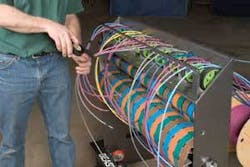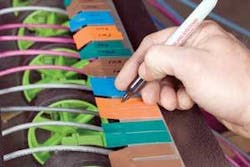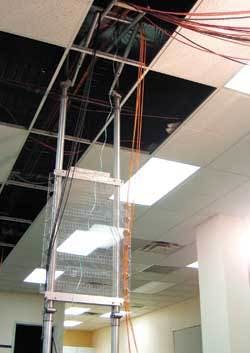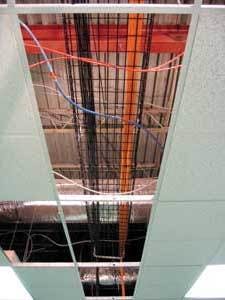In the face of advanced technology and copper cabling’s unwavering position in the marketplace, taking installation methods to a new level can provide benefits for all.
The cabling industry is abuzz over the development of the TIA/EIA Augmented Category 6 standard for 10-Gigabit Ethernet (GbE) transmissions over copper cabling. With the new standard buoying copper cabling’s unwavering position in the marketplace, the good news is that installers can expect to be pulling cable for many years to come.
But while cabling continues to undergo significant technological improvements, the method of installation has changed little over the past 40 years. With advanced network speeds, however, proper material handling (i.e., cable installation) is more critical than ever to ensure network performance, flexibility, and lifespan. End users, installers, and manufacturers alike can benefit from the use of cable installation systems (CIS), which save time and money while improving the overall installation process for network performance and manageability.
Tried and true no more
With improvements in cabling technology, awareness of the importance of proper cabling installation has increased, and industry standards have addressed critical issues, such as bend radius and tensile load ratings. Despite these significant specifications, the actual method of pulling cable from the telecommunications room (TR) to the workstation has remained virtually unchanged since the days of plain old telephone systems (POTS).
In most network cabling installations, installers set up cable spools or boxes outside the TR to prepare for pulling cables to workstation outlets and backfeeding them into the TR for termination at the patch panel. A jet line (pull string) is tied to a bundle of cables and to a second lagging jet line, and installers positioned at the workstation pull the cables at 90° turns into the ceiling and through the pathway. Unfortunately, makeshift entry points that support cables as they enter the pathway can become points of friction that stress cabling over time. Further, as cables are being pulled, most of the tension is placed on the cables at the outside of the bundle, which can further stress those cables.
As the cabling bundle is pulled through the pathway, it twists along with the lagging jet line, causing friction and difficulty for subsequent pulls. After several pulls, cable lubricant can ease friction, but more often than not, the time-consuming process of running a new jet line is required.
For many years, this tried-and-true method has proven successful for pulling cable. Today, however, advanced cables that carry enormous amounts of information at higher speeds are becoming increasingly sensitive to the method of handling and installation.
The 10GBase-T (IEEE 802.3an) and TIA/EIA Augmented Category 6 standards under development have identified alien near-end crosstalk (ANEXT) as the significant parameter limiting 10-GbE performance over a 100-meter copper channel. ANEXT, caused by signals coupling between adjacent copper cables and connecting hardware, is increased by the tendency of cables to absorb signals from neighboring cables in too close proximity. To avoid ANEXT, the standards will likely recommend loose, random installation for Augmented Category 6 cabling within pathways, as opposed to tight, twisted bundles.
“On one hand, we’re dealing with higher speed cable that requires more care in the installation process,” says Hal Kern, vice president of Powercom (www.powercom.com) of New Rochelle, NY. “On the other, we can’t sacrifice the quality and efficiency of our work. It’s become obvious that installation methods need to change to continue providing the best service to our customers and trouble-free installation of next-generation cables.”
A recipe for waste and risk
In addition to possible performance degradation, today’s cable installation methods can result in material waste and abandoned cable, ultimately affecting the bottom line for both installers and end users.
“While skilled crews work hard to manage cable quantities, sometimes there isn’t enough cable remaining in a box or on a spool for the next pull, and often that remaining cable is discarded,” explains Greg Bramham, vice president of sales and marketing for Beast Cabling Systems (www.thebeast.us).
When budgeting for a job, installers build in a buffer of about 10% to 15% for waste, but these numbers are not always realistic. Upon viewing final testing results, installers are often shocked to discover the amount of cable installed versus the amount bid for and purchased. Even the best installers end up with between 17% and 25% waste. At approximately $0.30 to $0.50 per foot of cable, that waste ends up costing between $50,000 and $125,000 for someone installing one million feet of cable per year.
How does this waste occur? Cables that fall short of performance specifications are often removed and discarded. Further, crews backfeeding cable into the TR almost always add 10 to 15 feet of length to ensure that they don’t come up short. In a TR with 600 terminations, this can equal up to 9,000 feet of waste. “With legacy installation methods, it’s natural for installers to take the conservative approach,” notes Powercom’s Kern. “They would rather be a mile too long than an inch too short.”
Today’s installation methods can also create the potential for abandoned cabling, and expensive moves, adds, and changes (MACs), which follow virtually every network installation. And if cables are twisted in the pathway, reusing or removing them can involve a costly, time-consuming process. The hassle of removing the twisted cable, as well as end user concerns of damaging other cables in the pathway, often leads to cables simply being cut and abandoned.
The labor of labeling
Proper labeling of a cabling infrastructure results in a professional installation and minimizes confusion by confirming which cables are connected to which workstations. While the TIA/EIA 606-A Administration Standard for Telecommunications Infrastructure addresses the final labeling of infrastructure, few guidelines exist for the process of “rough-in labeling,” or coding.
Some installers write rough-in codes directly onto both ends of the cable jacket with a marker, a process subject to human error and where codes can become smudged. Others use preprinted sheets of labels, which can become lost or damaged at the job site. Portable label makers are effective but time-consuming, and can easily run out of batteries or malfunction. When that happens, many installers revert back to writing rough-in labels onto the cable jacket.
The accuracy of rough-in labeling directly affects the final labeling scheme’s quality, and the time needed to complete it. Inaccurate rough-in codes can mean having to identify cables with a tone and probe for subsequent re-routing in the TR.
“If we pull 1,000 cables and two are labeled incorrectly, we don’t have a two-cable problems-we have a 1,000-cable problem,” contends James Barger, RCDD, manager of technical services at the Allison Smith Company (www.allisonsmith.com) of Atlanta, GA. “We don’t know which two cables are wrong, and it ends up being a combination of hunt, peck, and hope.” In worst-case scenarios, inaccurate rough-in codes can result in inaccurate final labeling, impacting end users, or in complete cable removal, yielding extensive material waste.
New answers to old problems
The combination of inadequate network performance, material waste, abandoned cable, and problematic labeling result in an increased overall investment cost. Using a comprehensive CIS, however, addresses each aspect of the cabling installation process and can provide the following benefits for lower investment costs:
• Uncomplicated setup and economical management of material;
• Fast, easy, and accurate identification and labeling;
• Proper and effective pulling of cables into the pathway;
• Better ultimate arrangement of cables in the pathway.
Uncomplicated setup. A CIS can save labor by facilitating the setup of larger spools of cable, eliminating the need for makeshift assembly of jack stands and ladders. Because a CIS holds enough cable for an entire day of installation, less time is spent reloading. The use of larger spools also drastically reduces waste. Most crews waste approximately 100 feet of cable per spool, regardless of the size of the spool. Therefore, a crew using ten 1,000-foot spools will waste 1,000 feet of cable, while crews using four 2,500-foot spools will waste only 400 feet-a 60% reduction in cable waste.
A CIS provides additional waste savings by calculating length as cable is pulled off the spool, facilitating the tracking of how much has been used and how much is needed for backfeeding into the TR. “With a CIS, our installers can now meter every cable off the reel, and they send a lot less cable to the dumpster,” maintains Powercom’s Kern.
Accurate identification, labeling. A CIS provides a consistent working location to maintain separation and organization of each cable pulled through the pathway and back to the TR, and offers a system for easily and properly identifying and labeling cables. Such efficiency reduces errors associated with the cumbersome task of sorting through disorganized cables and with current rough-in labeling processes, thus providing a foundation for a fully and properly labeled infrastructure.
“We typically have three crew members roughing-in the cable, and while one installer is labeling, the other two just wait,” says Allison Smith’s Barger. “Speeding up the labeling process with our CIS has reduced the labor time of three installers, not just one.”
Proper and effective pulling. A CIS reduces twisted and damaged cable, friction, and broken lead strings during installation by providing equal tension on every cable and by maintaining a natural separation of cables as they are pulled into the pathway. The end result is installations of better quality with reduced stress on cabling, and fewer incidents of kinks and jacket burn, which can ultimately degrade network performance. By reducing twisting and maintaining separation of cables, subsequent pulls are easier and faster, and jet line replacement reduced.
“It used to be a case of babysitting every little cable to make sure we didn’t over-strain it, over-pack it, twist it, or kink it in any way,” notes Frank Bisbee, president of Communication Planning Corp.(www.communicationplanning.com) of Jacksonville, FL. “A CIS allows us to now pull the cables in flat without twisting, which really helps us achieve the craft-intensive requirements of today’s cabling.”
Better cable arrangement in the pathway. Instead of tight, twisted bundles, a CIS maintains a natural separation of cables in the pathway, for easier identification and removal of specific cables, if needed. This effect reduces the cost of MACs and the tendency to abandon unnecessary cables in the pathway. In addition, the natural separation of cables is imperative for maintaining the ANEXT performance of tomorrow’s Augmented Category 6 cables for 10-GbE applications.
A benefit for all
While copper cabling’s unwavering position in the marketplace is good news for installers, it’s important to understand the inadequacies surrounding many of today’s cabling installation methods, and to recognize that tomorrow’s advanced cabling must benefit from a new approach. “The margin for error has gotten smaller and smaller,” cautions Bisbee. “If you’re not using a CIS that supports the installation correctly, you’re doomed to spend much more time and labor trying to fix problems that can occur using legacy installation methods.”
Cable manufacturers who embrace the concept of the CIS for implementation into their training programs can more credibly guarantee proper installation and maximum performance-especially important considerations with 10-GbE copper cabling. “Cabling manufacturers are faced with material cost increases, and their pricing strategy includes raising the cost of Category 5e cabling to drive buyers to Category 6,” adds Bisbee. “As they’re trying to get customers to swallow higher prices, they should consider ancillary systems like CIS to improve installation and sweeten the value statement.”
Across the cabling industry, the ultimate goal is to provide a flexible, durable, and long-lasting asset to the customer. “If we can holistically manage the installation process with a CIS that ensures performance, consistency, accuracy, and labor and material savings, that’s our best chance for satisfying the customer’s needs in a cost-effective, efficient manner,” asserts Beast Cabling Systems’ vice president Bramham. “The abundance of opportunities facing installers today is exciting, and installers can use CIS to set themselves apart from the competition.” As the industry becomes educated regarding the benefits of a CIS-better network performance, increased labor savings, and overall reduced investment costs-end users may eventually specify the use of a CIS in their bidding processes.
“Due to diverse environments, ceiling heights, and other external factors, the process of roughing-in cable is the most unpredictable aspect of any cabling installation, making it virtually impossible to determine how many man hours it will take,” says Allison Smith’s Barger. “Our CIS brings stability and standardization to that extremely variable process for more repeatable results, which is good news for everybody.”
Barger concludes, “I believe we’re in a transition, and more people will start using a CIS. I don’t know how long it will take-maybe three years, maybe five-but I believe at some point, using a CIS will simply be the way it’s done.”BETSY ZIOBRON is a freelance writer for the cabling industry and a regular contributor to Cabling Installation & Maintenance. She wrote this article on behalf of Beast Cabling Systems (www.thebeast.us).






